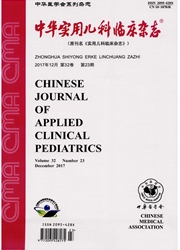

 中文摘要:
中文摘要:
目的探讨新生儿科住院患儿院内肺部真菌感染(NIPFI)的流行病学及其危险因素。方法选取2006年7月1日-2008年6月30日在广东省人民医院新生儿科住院的患儿中符合院内深部真菌感染(NIFI)诊断标准的婴儿[日龄(77±61)d]共68例。收集患儿一般资料、感染前诊疗经过、标本类型等,并对NIPFI及其他NIFI患儿各项数据进行比较。应用SPSS 13.0软件进行统计学分析。结果住院患儿NIFI发病率为3.31%(68/2 052例),其中NIPFI发生率为1.36%(28/2 052例)。NIPFI患儿总住院时间中位数为15.50 d;心血管疾病患病率为94.6%,感染真菌前广谱抗生素的使用率为96.4%,抗生素的联合应用占64.3%;78.6%的患儿接受了心脏手术;机械通气率为82.1%;中心静脉置管为67.9%;留置胃管率为96.4%;激素使用者占78.6%。NIPFI患儿机械通气率较其他NIFI患儿高(χ2=7.32,P=0.010);余因素在2组患儿间比较差异均无统计学意义。多元回归分析显示机械通气与NIPFI有显著相关性(OR=0.229,95%CI0.072~0.725,P=0.012)。结论在NIFI的各种危险因素中,机械通气是NIPFI的危险因素。
 英文摘要:
英文摘要:
Objective To explore the epidemiology of nosocomial invasive pulmonary fungal infection(NIPFI) in the Department of Neonatology and analyze the risk factors,provide evidence for proper diagnostic and treating handlings.Methods Sixty-eight infants which aged(77±61) d with nosocomial invasive fungal infection(NIFI),who hospitalized in Guangdong General Hospital from Jul.1,2006 to Jun.30,2008 were enrolled in the study.All the clinical data,including general situation,pre-infection management,types of collected samples and the data of NIPFI and other NIFI were retrospectively analyzed.SPSS 13.0 software was used to analyze the data.Results The incidence of NIPFI was 1.36%(28/2 052 cases).The median hospital stay before NIPFI was 15.50 days.All the patients suffered from more than one critical primary diseases,94.6% of which were congenital cardiovascular disease,96.4% of the infants were managed with broad antimicrobial spectrum antibiotic,and 64.3% with antibiotics,78.6% of the infants received cardiovascular operations,glucocorticoid was used in 78.6%,central venous catheter indwelled in 67.9%,nasal-stomach tubes in 96.4%,82.1% patients were mechanically ventilated,which was significantly higher than that in other NIFI patients(χ2=7.32,P=0.010).Multiple regression analysis showed that NIPFI was positively correlated with mechanical ventilation(OR=0.229,95%CI 0.072-0.725,P=0.012).Conclusion Of all the risk factors for nosocomial invasive fungal infection,mechanical ventilation is the risk factor for NIPFI.
 同期刊论文项目
同期刊论文项目
 同项目期刊论文
同项目期刊论文
 期刊信息
期刊信息
